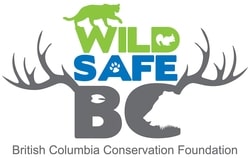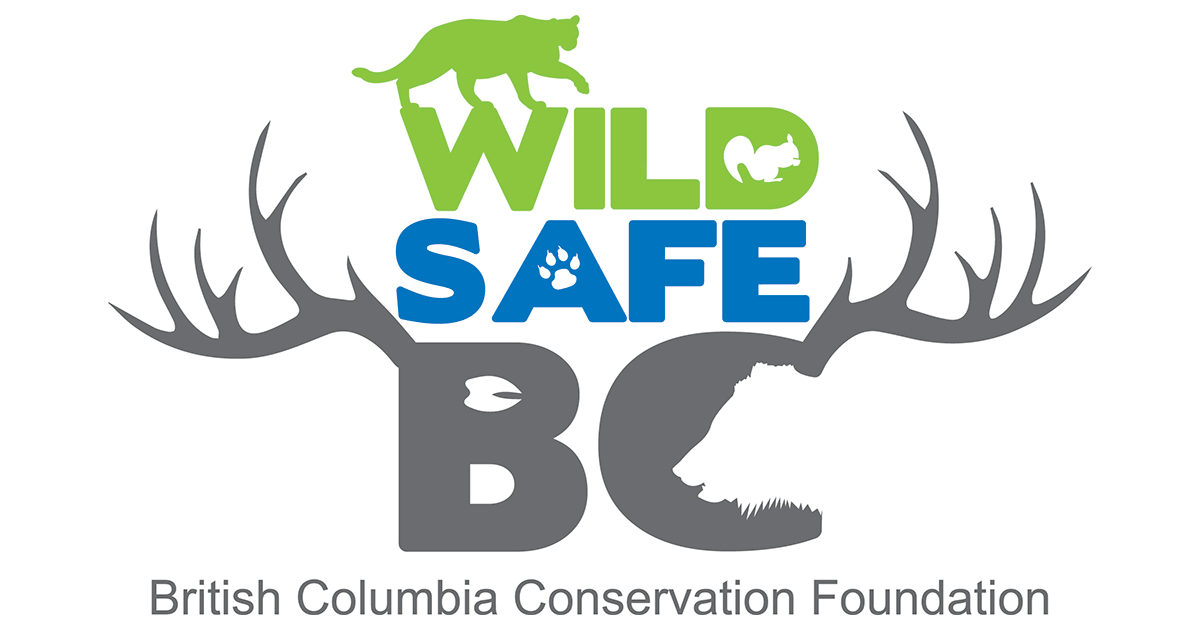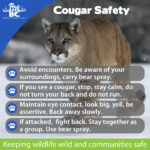Cougar
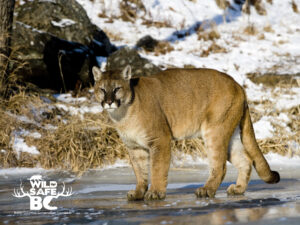 Cougar Snapshot
Cougar Snapshot
The cougar (Puma concolor) is the largest of the three wild cats in Canada and is a formidable hunter. They are also known as mountain lions, pumas and panthers. They are strict carnivores that primarily feed on deer and their distribution hence aligns strongly with our two deer species. These cats are light brown in colour and are quickly identified by their compact head and a long heavy tail which is about one-third the length of their body and has a black tip.
Cougars account for approximately 2,500 calls to the Conservation Officer Service reporting line every year, however many reported cougar sightings turn out to be animals other than cougars. Cougar attacks are very rare, but if you encounter a cougar, keep calm and never run. Make yourself look as large as possible and back away slowly, keeping the cougar in view, and allowing a clear exit for the cougar. If attacked, always fight back and never “play dead”. If travelling with small children, pick them up immediately. Children are most at risk in a cougar encounter and they should be taught how to behave appropriately (see "Children and Cougars" in "Safety") to stay safe.
To report cougars in conflict, sightings in urban areas, or a cougar showing unusual or aggressive behaviour, call the Conservation Officer Service at 1-877-952-7277.
Wild Cougar Facts
- Cougars can sprint to over 70 km/hr
- Cougar tracks tend to lack claw marks as they have retractable claws
- Cougars are widely distributed throughout BC and have the one of the largest species ranges in the Northern hemisphere
- Cougars are the largest wild felines in the province followed by lynx and bobcat
- Cougars are strict carnivores that usually hunt deer but are known to kill other ungulates such as sheep, elk and moose, as well as small mammals
Identification
Cougars tend to be light brown in colour with lighter patches under the chin and underside. They can be identified by their compact head and long heavy tail which is about one-third the length of their body and has a black tip. Cougar tracks have large padded prints with no claws showing. Like domestic cats, cougars keep their claws retracted until needed for attacking their prey or climbing trees.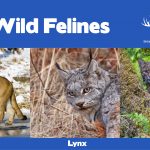
Biology
Cougars are solitary animals in that they do not cooperate with others for survival purposes except for when females who are raising their young and when mating. However, recent research has shown that related cougars will socialize temporarily at kill sites. Cougars will typically mate all year round but in western Canada there is an increase in mating and birthing between May and October.
They typically have anywhere from one to six kittens but three is the average. Kittens remain with their mothers until they are 11 to 18 months old and thereafter will disperse in search of a new area to settle in. Males often leave first and will roam long distances while females often settle within and close to the area where they were born.
Cougars are carnivores and their main prey is mule and white-tailed deer; they also prey on all other ungulates found in their range including . In winter they also prey upon moose, beavers and even porcupines. On rare occasions they have been recorded to kill small mammals, birds and reptiles.
Since deer are one of the cougar’s primary food sources, there is a good possibility of finding cougars using an area where deer are abundant, especially a wintering area.
Large prey takes a number of days to eat and the cougar will pull debris over the carcass to keep off scavengers. The cougar will stay near a kill site, returning to it regularly until the prey is completely consumed. If you encounter a kill, leave the area immediately and report the location to local authorities and the BC Conservation Officer Service at 1-877-952-7277.
Behaviour
Contrary to popular belief, cougars do not pounce on their prey from overhanging rocks or trees, but stalk an animal and then use an explosive series of bounds to leap on their prey. Using both their sharp claws and powerful jaws they can quickly kill most prey they choose to attack. Their back legs are also longer than their forelegs allowing them to jump and bound in different terrains. Because cougars have a small lung capacity they are unable to run over long distances, like a wolf, so they are "stalk and ambush" predators and will remain concealed from their prey until they can ambush and attack from close range. While cougars are widely distributed across BC, they are secretive animals and are seldom seen by people. While cougars can be active day or night, they primarily hunt at dawn and dusk. When in proximity to human areas, or backcountry areas frequently utilised by people, cougars will avoid encountering people by moving more at night or during hours with minimal human activity.
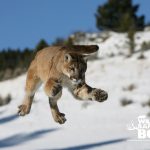
Range and Habitat
Cougars have large home ranges and males have been recorded traveling over 50 kilometers in one day. Cougars have one of the widest distributions of mammals in the Americas and can be found all the way from Patagonia into the southern reaches of the Yukon. In the summer season they seek areas close to water and with wetland cover. When denning with kittens a female will find a sheltered area amongst boulders, rocky outcrops and / or dense vegetation. Cougars will normally avoid roads and human areas, however cougars can live in urban areas and remain undetected by people.
WildSafe Tales Cougar Episode
This video was captured by a remote camera installed by the WildSafeBC Bella Coola Coordinator in 2021. The camera trap was set up discreetly by a deer carcass. A couple of days later the kill had been fully utilized and the memory card in the camera was full.
Wildlife Science
Cougar Safety
Cougars that come into conflict vary across ages and genders however research has suggested that subadult cougars come into conflict more often. Subadults, independent of their mothers, will attempt to find a new territory and may find themselves in urban areas. Unsecured livestock and pets can appear to be easy hunting opportunities. Older and/or injured cougars that may be struggling to hunt natural prey may also come into conflict. Urban deer can also increase cougar conflict by attracting these predators into human areas that they would otherwise avoid.
If you live in cougar habitat, ensure your children know how to react in a cougar encounter. Always report aggressive cougar behaviour, kill sites or cougar sightings in urban areas to the BC Conservation Officer Service.
The best cougar encounter is the one you avoid. Avoid walking alone and avoid surprise encounters by making noise with your voice. Note that loud water or high winds may prevent your voice from carrying far. Pets should be kept under control and on leash in wildlife country. Do not wear headphones so that you can be aware of your surroundings. Avoid hiking or using trails with poor sightlines at dawn and dusk when predators are most active.
If you encounter a cougar, keep calm and never run. Make yourself look as large as possible and back away slowly, keeping the cougar in view, and allowing a clear exit for the cougar. Pick up children and small pets immediately. Older children should be kept close and in front of you so that you can ensure they remain calm and don’t try to flee. Never run or turn your back as sudden movements may provoke an attack. Cougar may vocalize when cornered or acting defensive. These vocalizations can range from a “hissing” to a deep growling sound. This is often a warning to back off.
If you notice that a cougar that is watching you, maintain eye contact with the cougar and speak to it in a loud firm voice. Reinforce the fact that you are a human and not an easy target. If you have bear spray, withdraw it from the holster and remove the safety. Back out of the area and seek assistance or shelter.
If a cougar shows aggression, or begins to follow you, respond aggressively. Keep eye contact, yell and make loud noises. Never ‘play dead’. Without crouching down, pick up nearby sticks, rocks, or whatever you have at hand to quickly to use as a weapon if necessary.
If the cougar attacks, fight back, focusing on its facial and eye area. If you have bear spray, discharge it. Use rocks, sticks or personal belongings as weapons. You are trying to convince the cougar that you are a threat, and not prey. If you are in a group, stay together to fend off the cougar attack.
In the unlikely event you encounter cougar kittens (they are usually well-hidden by their mother), do not attempt to handle or approach them. Leave the area immediately.
Children and Cougars
Cougars may view children as prey targets due to their small size, high-pitched voices, and quick movements. Talk to your children and teach them what to do if they encounter a cougar. If you live in or near cougar habitat, here are some additional tips:
- Children should play in groups. Do not leave children unsupervised.
- Consider getting a dog or using a dog as an early warning system. A dog can see, smell and hear a cougar sooner than a human. However, be aware that off-leash dogs can attract and bring cougars and bears back to you.
- Consider erecting a fence around play areas. While cougars can leap or scale most fences, a solid wood fence that prevents a cougar from looking into a yard may lower the chance that a cougar will access the yard.
- Make sure children are home before dusk and stay indoors until after dawn - the period of time cougars are most active.
- If there have been cougar sightings, escort children to the bus stop early in the morning. Clear shrubs away from around the bus stops, making a radial area of about nine metres.
- Installing a light at the bus stop may also increase security.
Conflict Reduction with Cougars
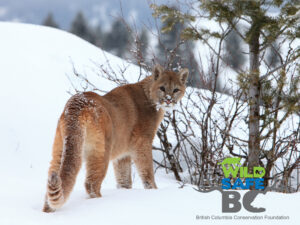 Cougars are widely distributed throughout BC and conflicts may occur at any time of the year. Occasionally, they may be observed in urban settings. If they are passing through, it is important they do not find prey items that may encourage them to stay.
Cougars are widely distributed throughout BC and conflicts may occur at any time of the year. Occasionally, they may be observed in urban settings. If they are passing through, it is important they do not find prey items that may encourage them to stay.
Keep your pets indoors, especially at night. Cats and dogs that are left to free-range can become easy prey targets. Feed your pets indoors. Uneaten pet food can attract cougars and other cougar prey species such as rodents (rats, squirrels) and raccoons.
Avoid feeding or attracting other wild animals that may be prey for cougars. Fallen seed from bird feeders can attract rodents which are potential prey for cougars. Deer should never be fed
If you keep chickens or small livestock, use a properly installed and maintained electric fence that is maintained regularly and should follow WildSafeBC’s electric fencing guidelines. Store all of your feed in a secure rodent-proof location and ensure feeding areas are clean and free of attractants. Chicken coops and runs should be covered as cougars may leap or climb over fencing. Put small domestic livestock in an enclosed area at night. Use lighting around barns and pens to deter predators. Refer to Growing in Wildlife Country for more information on raising livestock in cougar habitat.
Repellents and scare devices currently on the market may be an attractive option to deter cougars, however cougars are intelligent and quickly adapt. If you wish to try such devices, using a combination of devices and/or alternating between them may be more effective. Devices include lighting and flashing lights, sound amplifiers, horns, and propane cannons. There are currently no known odour or taste repellents that are effective on cougars.
Check with your local bylaws before using any of the above devices.
Cougar Resources
- BC Conservation Data Centre
- Klinkenberg, Brian, editor. 2019. E-Fauna BC: Electronic Atlas of the Fauna of British Columbia. Vancouver, BC: Lab for Advanced Spatial Analysis, Department of Geography, University of British Columbia.
- Province of British Columbia. Ministry of Environment and Climate Change Strategy. Cougars.
 Cougar Snapshot
Cougar Snapshot
The cougar (Puma concolor) is the largest of the three wild cats in Canada and is a formidable hunter. They are also known as mountain lions, pumas and panthers. They are strict carnivores that primarily feed on deer and their distribution hence aligns strongly with our two deer species. These cats are light brown in colour and are quickly identified by their compact head and a long heavy tail which is about one-third the length of their body and has a black tip.
Cougars account for approximately 2,500 calls to the Conservation Officer Service reporting line every year, however many reported cougar sightings turn out to be animals other than cougars. Cougar attacks are very rare, but if you encounter a cougar, keep calm and never run. Make yourself look as large as possible and back away slowly, keeping the cougar in view, and allowing a clear exit for the cougar. If attacked, always fight back and never “play dead”. If travelling with small children, pick them up immediately. Children are most at risk in a cougar encounter and they should be taught how to behave appropriately (see "Children and Cougars" in "Safety") to stay safe.
To report cougars in conflict, sightings in urban areas, or a cougar showing unusual or aggressive behaviour, call the Conservation Officer Service at 1-877-952-7277.
Wild Cougar Facts
- Cougars can sprint to over 70 km/hr
- Cougar tracks tend to lack claw marks as they have retractable claws
- Cougars are widely distributed throughout BC and have the one of the largest species ranges in the Northern hemisphere
- Cougars are the largest wild felines in the province followed by lynx and bobcat
- Cougars are strict carnivores that usually hunt deer but are known to kill other ungulates such as sheep, elk and moose, as well as small mammals
Identification
Cougars tend to be light brown in colour with lighter patches under the chin and underside. They can be identified by their compact head and long heavy tail which is about one-third the length of their body and has a black tip. Cougar tracks have large padded prints with no claws showing. Like domestic cats, cougars keep their claws retracted until needed for attacking their prey or climbing trees.
Biology
Cougars are solitary animals in that they do not cooperate with others for survival purposes except for when females who are raising their young and when mating. However, recent research has shown that related cougars will socialize temporarily at kill sites. Cougars will typically mate all year round but in western Canada there is an increase in mating and birthing between May and October.
They typically have anywhere from one to six kittens but three is the average. Kittens remain with their mothers until they are 11 to 18 months old and thereafter will disperse in search of a new area to settle in. Males often leave first and will roam long distances while females often settle within and close to the area where they were born.
Cougars are carnivores and their main prey is mule and white-tailed deer; they also prey on all other ungulates found in their range including . In winter they also prey upon moose, beavers and even porcupines. On rare occasions they have been recorded to kill small mammals, birds and reptiles.
Since deer are one of the cougar’s primary food sources, there is a good possibility of finding cougars using an area where deer are abundant, especially a wintering area.
Large prey takes a number of days to eat and the cougar will pull debris over the carcass to keep off scavengers. The cougar will stay near a kill site, returning to it regularly until the prey is completely consumed. If you encounter a kill, leave the area immediately and report the location to local authorities and the BC Conservation Officer Service at 1-877-952-7277.
Behaviour
Contrary to popular belief, cougars do not pounce on their prey from overhanging rocks or trees, but stalk an animal and then use an explosive series of bounds to leap on their prey. Using both their sharp claws and powerful jaws they can quickly kill most prey they choose to attack. Their back legs are also longer than their forelegs allowing them to jump and bound in different terrains. Because cougars have a small lung capacity they are unable to run over long distances, like a wolf, so they are "stalk and ambush" predators and will remain concealed from their prey until they can ambush and attack from close range. While cougars are widely distributed across BC, they are secretive animals and are seldom seen by people. While cougars can be active day or night, they primarily hunt at dawn and dusk. When in proximity to human areas, or backcountry areas frequently utilised by people, cougars will avoid encountering people by moving more at night or during hours with minimal human activity.

Range and Habitat
Cougars have large home ranges and males have been recorded traveling over 50 kilometers in one day. Cougars have one of the widest distributions of mammals in the Americas and can be found all the way from Patagonia into the southern reaches of the Yukon. In the summer season they seek areas close to water and with wetland cover. When denning with kittens a female will find a sheltered area amongst boulders, rocky outcrops and / or dense vegetation. Cougars will normally avoid roads and human areas, however cougars can live in urban areas and remain undetected by people.
WildSafe Tales Cougar Episode
This video was captured by a remote camera installed by the WildSafeBC Bella Coola Coordinator in 2021. The camera trap was set up discreetly by a deer carcass. A couple of days later the kill had been fully utilized and the memory card in the camera was full.
Wildlife Science
Cougar Safety
Cougars that come into conflict vary across ages and genders however research has suggested that subadult cougars come into conflict more often. Subadults, independent of their mothers, will attempt to find a new territory and may find themselves in urban areas. Unsecured livestock and pets can appear to be easy hunting opportunities. Older and/or injured cougars that may be struggling to hunt natural prey may also come into conflict. Urban deer can also increase cougar conflict by attracting these predators into human areas that they would otherwise avoid.
If you live in cougar habitat, ensure your children know how to react in a cougar encounter. Always report aggressive cougar behaviour, kill sites or cougar sightings in urban areas to the BC Conservation Officer Service.
The best cougar encounter is the one you avoid. Avoid walking alone and avoid surprise encounters by making noise with your voice. Note that loud water or high winds may prevent your voice from carrying far. Pets should be kept under control and on leash in wildlife country. Do not wear headphones so that you can be aware of your surroundings. Avoid hiking or using trails with poor sightlines at dawn and dusk when predators are most active.
If you encounter a cougar, keep calm and never run. Make yourself look as large as possible and back away slowly, keeping the cougar in view, and allowing a clear exit for the cougar. Pick up children and small pets immediately. Older children should be kept close and in front of you so that you can ensure they remain calm and don’t try to flee. Never run or turn your back as sudden movements may provoke an attack. Cougar may vocalize when cornered or acting defensive. These vocalizations can range from a “hissing” to a deep growling sound. This is often a warning to back off.
If you notice that a cougar that is watching you, maintain eye contact with the cougar and speak to it in a loud firm voice. Reinforce the fact that you are a human and not an easy target. If you have bear spray, withdraw it from the holster and remove the safety. Back out of the area and seek assistance or shelter.
If a cougar shows aggression, or begins to follow you, respond aggressively. Keep eye contact, yell and make loud noises. Never ‘play dead’. Without crouching down, pick up nearby sticks, rocks, or whatever you have at hand to quickly to use as a weapon if necessary.
If the cougar attacks, fight back, focusing on its facial and eye area. If you have bear spray, discharge it. Use rocks, sticks or personal belongings as weapons. You are trying to convince the cougar that you are a threat, and not prey. If you are in a group, stay together to fend off the cougar attack.
In the unlikely event you encounter cougar kittens (they are usually well-hidden by their mother), do not attempt to handle or approach them. Leave the area immediately.
Children and Cougars
Cougars may view children as prey targets due to their small size, high-pitched voices, and quick movements. Talk to your children and teach them what to do if they encounter a cougar. If you live in or near cougar habitat, here are some additional tips:
- Children should play in groups. Do not leave children unsupervised.
- Consider getting a dog or using a dog as an early warning system. A dog can see, smell and hear a cougar sooner than a human. However, be aware that off-leash dogs can attract and bring cougars and bears back to you.
- Consider erecting a fence around play areas. While cougars can leap or scale most fences, a solid wood fence that prevents a cougar from looking into a yard may lower the chance that a cougar will access the yard.
- Make sure children are home before dusk and stay indoors until after dawn - the period of time cougars are most active.
- If there have been cougar sightings, escort children to the bus stop early in the morning. Clear shrubs away from around the bus stops, making a radial area of about nine metres.
- Installing a light at the bus stop may also increase security.
Conflict Reduction with Cougars
 Cougars are widely distributed throughout BC and conflicts may occur at any time of the year. Occasionally, they may be observed in urban settings. If they are passing through, it is important they do not find prey items that may encourage them to stay.
Cougars are widely distributed throughout BC and conflicts may occur at any time of the year. Occasionally, they may be observed in urban settings. If they are passing through, it is important they do not find prey items that may encourage them to stay.
Keep your pets indoors, especially at night. Cats and dogs that are left to free-range can become easy prey targets. Feed your pets indoors. Uneaten pet food can attract cougars and other cougar prey species such as rodents (rats, squirrels) and raccoons.
Avoid feeding or attracting other wild animals that may be prey for cougars. Fallen seed from bird feeders can attract rodents which are potential prey for cougars. Deer should never be fed
If you keep chickens or small livestock, use a properly installed and maintained electric fence that is maintained regularly and should follow WildSafeBC’s electric fencing guidelines. Store all of your feed in a secure rodent-proof location and ensure feeding areas are clean and free of attractants. Chicken coops and runs should be covered as cougars may leap or climb over fencing. Put small domestic livestock in an enclosed area at night. Use lighting around barns and pens to deter predators. Refer to Growing in Wildlife Country for more information on raising livestock in cougar habitat.
Repellents and scare devices currently on the market may be an attractive option to deter cougars, however cougars are intelligent and quickly adapt. If you wish to try such devices, using a combination of devices and/or alternating between them may be more effective. Devices include lighting and flashing lights, sound amplifiers, horns, and propane cannons. There are currently no known odour or taste repellents that are effective on cougars.
Check with your local bylaws before using any of the above devices.
Cougar Resources
- BC Conservation Data Centre
- Klinkenberg, Brian, editor. 2019. E-Fauna BC: Electronic Atlas of the Fauna of British Columbia. Vancouver, BC: Lab for Advanced Spatial Analysis, Department of Geography, University of British Columbia.
- Province of British Columbia. Ministry of Environment and Climate Change Strategy. Cougars.
